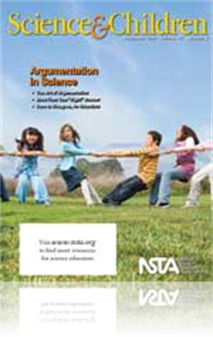All Science and Children resources
Journal Article
Dare to Disagree, as Scientists
As argumentation is weaved into classroom lessons, students know what to ask, how to analyze the given information before forming a conclusion, and are able to support their reasoning with solid evidence. They will hold firm to their conclusions unti...
Journal Article
Methods and Strategies: Connecting Science and Literacy Through Talk
When students are motivated, engaged, and have opportunities to practice and develop discussion skills taught during literacy time, they can deepen their understanding of science concepts. Communication is an important tool for the development of sci...
Journal Article
The Early Years: A Reason to Write
Children love seeing their work and photos of themselves at work. Make this an opportunity for an early literacy experience by creating a book about a classroom investigation. Document each step of the process with photographs and student drawings. W...
Journal Article
Science 101: How can wind cause a bridge to collapse?
First, you might need evidence that wind can cause a bridge to collapse. To see the evidence, put “Tacoma Narrows Bridge collapse” into any internet search engine. Using this example from 1940 and a series of hands-on activities that demonstrate ...
Journal Article
Methods and Strategies: Literacy in the Learning Cycle
Trade books can be used in all phases of the learning cycle to support effective teaching and learning. Romance and Vitale (1992) found that texts and other nonfiction science books can be effective tools for teaching reading, as the science activiti...
Journal Article
Providing opportunities for students to grapple with collecting and organizing data, struggle with how to represent and communicate ideas emerging from the data, and consider the alignment of these ideas with the science content being learned is refl...
Journal Article
Natural Resources: For the Birds
More than ticking off a checklist (though that is fun, too), birding fosters an appreciation for nature. The following citizen science opportunities connect children to the scientific community. The websites listed here include tips on feeding and ob...
Journal Article
The Early Years: Safe Smelling
Using the sense of smell, animals find food or a mate and detect the presence of predators; their survival depends on this. In a discussion on using our sense of smell to keep use safe, some children may relate experiences of smelling something burni...
Journal Article
In a unique school—university partnership, methods students collaborated with fifth graders to use the engineering design process to build their problem-solving skills. By placing the problem in the context of a client having particular needs, the ...
Journal Article
Teaching through Trade Books: Secrets of Flight
The date was December 17, 1903. The place was a windswept beach near Kitty hawk, North Carolina. With Orville Wright at the controls and his brother Wilbur running alongside, the plane took off. This event lasted only 12 seconds, but it made history ...
Journal Article
Editor’s Note: Creating Problem Solvers
You’ll see that even young children are able to raise questions about the world around them and are willing to seek answers while making careful observations. Although there is no prescription for how to problem solve, the author provides some sugg...
Journal Article
Today’s Authors, Tomorrow’s Scientists
Although not all teachers can invite scientists into classrooms on a regular basis, they can invite them into their students’ worlds through literature. Here the author shares how she used the nonfiction selection, Science to the Rescue (Markle 199...




